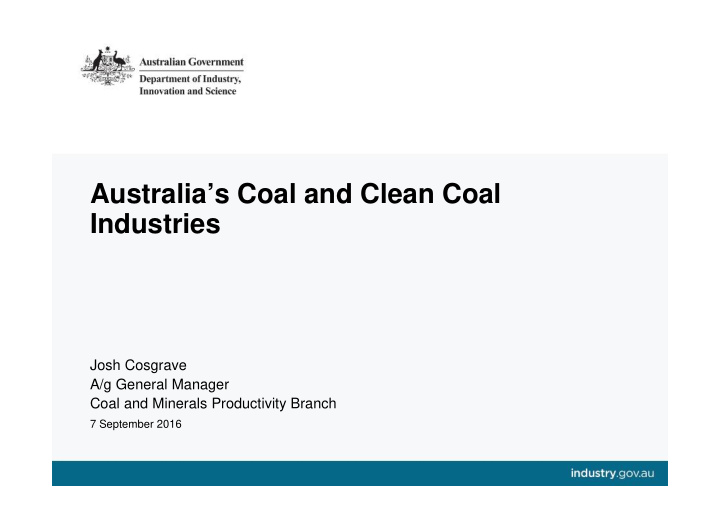



Australia’s Coal and Clean Coal Industries Josh Cosgrave A/g General Manager Coal and Minerals Productivity Branch 7 September 2016
Australia’s coal industry • Major global producer and exporter Australia’s thermal coal costs of coal: largest exporter and 5 th (energy adjusted) largest producer in 2015. • Challenging market conditions: Resulting from a excess supply capacity and lower prices. • Cost cutting has improved project viability: Largely achieved through wage and staffing reductions. • Industry wide asset consolidation: Resulted in a number of sales and acquisitions. • Prices have stabilised: Global Source: AME Group. production cuts have eased pressure on the market.
Global Coal Industry Outlook World electricity generation, by fuel 45 • Weak growth in demand: 40 However, coal will remain the 35 dominant energy source for electricity generation to 2040. 30 % 25 • Slowing growth in production: Driven by mine closures and 20 production curtailments. 15 • Few projects in development: 10 Projects are more likely to be 5 expansions of existing 0 operations over greenfields. Coal Oil Gas Nuclear Hydro other renewable 2013 2040 Source : IEA (2015) World Energy Outlook.
Australian Export Outlook Australia’s metallurgical coal exports 200 50 160 40 2015–16 A$ billion • Limited growth in volumes: Million tonnes 120 30 Closure of operations 80 20 expected to offset new 40 10 capacity. 0 0 2001–02 2004–05 2007–08 2010–11 2013–14 2016–17 Volume Value (rhs) • Export earnings to remain Australia’s thermal coal exports low over medium term: 250 25 2015–16 A$ billion There has been subdued 200 20 Million tonnes 150 15 production growth over the 100 10 last 5 years and this is 50 5 reflected in the export 0 0 profile. 2001–02 2004–05 2007–08 2010–11 2013–14 2016–17 Volume Value (rhs) Source: Department of Industry, Innovation and Science.
Australia’s recoverable coal resources are large and high quality 120 Australia has large coal resources. 100 The large increase in coal 80 resources since 2008 was the result of increased exploration and reclassification of 60 resources 40 Australian coal typically has high energy content; low 20 sulphur and low-medium ash Gt 1976 1982 1988 1994 2000 2006 2012 Highly suitable for modern, high efficiency coal power Black Coal Brown coal plants
Challenges facing Australian coal projects Market Conditions • Prices • Environmental and climate policies • Import demand • Non-tariff barriers Opposition to coal mine developments • Localised project protests • Larger environmental campaigns Finance • Difficulty obtaining finance – broader industry issue • The fossil-fuel divestment campaign
Addressing the challenges • Positive signs in the market • Working with jurisdictions • Regulatory Reform • Improving social licence conditions • Climate change policy toolkit
The development of low emission options may create opportunities for Australian coal More new plants are planning to use HELE technology • Improving thermal efficiency will help achieve meaningful reductions in emissions • Many new plants being developed worldwide are based on supercritical technologies or better • These plants will be better placed to integrate CCS when conditions are appropriate • There are also options to retrofit or prepare existing plants for retrofitting for advanced low emission technologies • New financing arrangements within the OECD encourage HELE while addressing the energy requirements of countries like India and Indonesia Australia’s coal is well suited to use in HELE plants
Australia’s policy focus for low emissions technologies • Australia’s Strategic Policy: Energy White Paper • Australia’s policy focus for low emissions technologies: – Improving knowledge base of Australia’s CCS resources – Demonstrate domestic LET capacities and capabilities – Strategic Partnering – Building Australian skills and capacity • Australian Government commitment of approximately AUD 600 million to a range of low emission technology activities.
Australia: Selection of Key Low Emission Technology Projects & Key Research Initiatives • CarbonNet: – Feasibility of commercial scale CCS; project investigating full end-to-end CCS chain – Kawasaki Heavy Industries have noted interest in partnering with CCS projects such as CarbonNet. • Callide: Gorgon – Government of Japan – Australian industry collaboration Callide – World first oxyfuel combustion pairing with carbon capture in March 2015 – J-POWER significant project partner. • Gorgon: – Set to be world’s largest commercial scale CCS project; Reduce Gorgon’s GHG by 40% – JV includes Osaka Gas, Tokyo Gas and Chubu Electric Power. Otway • Otway: CarbonNet – World class CO2 injection testing facility – Internationally significant contribution to CO2 storage science and engineering • CCS RD&D: – New AUD 25 million Programme supporting CO2 storage and RD&D.
Key messages • Australia is a long-term dependable supplier of coal and other resources to the world. • The industry will face short term challenges, but longer term prospects are promising. • The Australian Government is working closely with jurisdictions and citizens to address industry challenges. • The large-scale investment undertaken in Australia’s coal sector over the last decade has increased our productive capacity. • Australia’s supply capacity, geographical location and coal quality ensures we are well positioned to meet future increases in coal demand in the region. • Australia is home to a number of low emission technology projects of international significance and opportunities for further international collaboration are welcomed.
Department of Industry, Innovation and Science Industry House 10 Binara Street Canberra City, ACT 2601, Australia Telephone +61 2 6213 6000 Email: LowEmissions@industry.gov.au
Recommend
More recommend